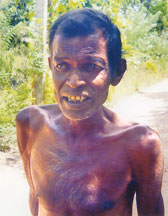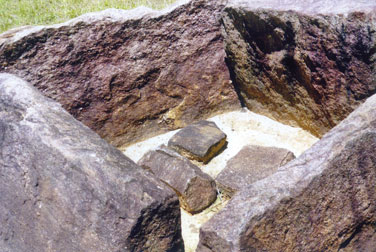Ibbankatuwa - an unknown archaeological site
Text and pix: M. A. R. Manukulasooriya, Hiriyala
group correspondent
There are several places of historical significance in Sri Lanka that
are still not known among locals and as well as foreigners.

W. H. Tennakoon Banda |

Close up photograph of a tomb. |
The Ibbankatuwa historical cemetery that belongs to the Megalithic
pre-historic era is one such place. The historical site is on the
Kurunegala-Dambulla main road, 500 metres from the main road in the
Galewela D.S. division.
The Ibbankatuwa site covers an area of about one square kilometre and
has 42 clusters of cist tombs with a rough average of about ten tombs
per cluster. The centuries- old cemetery shows that in ancient times
even the dead were respected.
These structures are similar to the ones we see in today's
cemeteries. These graves are enclosed with stone slabs and covered with
another slab. According to archaeologists, besides the burial place,
human bones and other paraphernalia such as equipment used by them have
been found from the site.
Dr. Senarath Paranavithana examined the inscriptions that appeared on
the clay pots found from this site had stated that they are similar to
the inscriptions that appeared in the clay pots found from the
Mohendajaro-Harappa civilisation. The excavations in this site were
first carried out in 1970 by the then Commissioner of Archaeology Dr.
Raja De Silva.
The site was again examined thoroughly by the officers of the
Cultural Triangle in 1982.
In a research paper written by Prof. Bandaranayake and Raj Somadeva,
a description of the cemetery has been given.
Ibbankatuwa can be considered the best investigated Megalithic
cemetery in Sri Lanka. The excavated area at cluster 21 measures
approximately 18 metres by 11 metres and contains 19 cists. Some of
these were intact with the capstone in the place. Many of them have
large Terracotta urns usually covered with a Terracotta dish or tray
bowl."

The nameboard which was put up by the Central Provincial Council
. |

Clusters of cist tombs |
Before the excavations were carried out, people had settled in this
site without knowing that it was a historical cemetery where twenty-one
families still live.
"These plots of lands were granted to us by the late minister T. B.
Tennakoon. It was in 1976. We put up huts here and settled as we did not
own at least an inch of land.
Now the officers of the Archaeological Department threaten us to
leave the site.
But how can we leave the place after living over forty years? The
responsible authorities should look into our plight and grant us some
sort of relief", said W. H. Tennakoon Banda (62), a father of six
children who lives in this site.
Although thousands of tourists pass this historical place almost
everyday, no one is interested in visiting this site as due publicity
has not been given by the authorities. At present this site is preserved
by the Department of Archaeology. |

